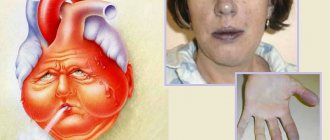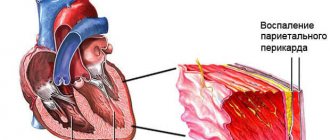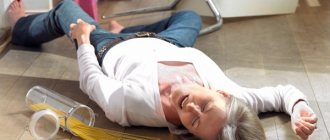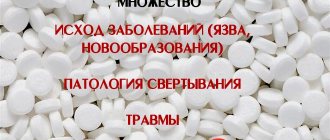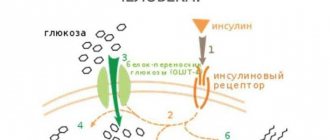Dangerous symptoms of cardiovascular diseases
The following signs may be harbingers of critical, life-threatening conditions:
- Sudden, sharp pain in the heart area that has never been experienced before.
- Severe weakness, severe shortness of breath, dizziness, loss of consciousness.
- A sudden attack of very strong or, conversely, weak heartbeat.
- Blue skin, cold sweat, swelling of the neck veins.
- Choking, wheezing of the lungs, bubbling breathing, cough with foamy reddish/pink sputum.
- Nausea and vomiting.
Having discovered such symptoms, especially for the first time, you should immediately call an ambulance and find someone who would monitor your condition and be able to provide assistance.
Cardiac glycosides
These are herbal medicines (contained in lily of the valley, digitalis) and have been used for more than 200 years.
They stimulate the heart, normalize blood circulation, and relieve swelling. They act on the body like caffeine and adrenaline. Cardiac glycosides from different plants differ slightly in their effects.
Prescribed to patients with both acute and chronic insufficiency, tachycardia arising from circulatory failure. Each of them can cause cardiac arrest if not taken with sufficient care.
The active ingredient is adenosine triphosphatase. This enzyme is of paramount importance for processes such as muscle contractions, the biosynthesis of various compounds, and the transport of substances across cell membranes.
By influencing energy metabolism and metabolic processes in the muscles of the heart, drugs of this group increase systole, stroke volume increases, blood pressure rises, and diastole increases, which reduces the load on the myocardium.
The heartbeat becomes more powerful, rhythmic, smooth, and calm.
Cardiac glycosides are excreted slowly, tend to accumulate, and intoxication is possible with long-term use or overdose.
Only an overdose will cause a heart attack. A few tablets can be a lethal dose. It is dangerous to take a dose increased by 10 times.
There are a number of contraindications in which even a small dose can cause a heart attack and become fatal: hypothyroidism, renal failure, lack of potassium or magnesium (hypomagnesemia and hypokalemia), excess calcium in the blood (hypercalcemia), hypoxia, cardiosclerosis after a heart attack.
Potassium preparations are used to treat intoxication.
Which pills should you keep in mind?
Preparations: digitoxin, digoxin and celanide (from foxglove woolly), adonizide (spring adonis), strophanthin (from strophanthus), corglycon (from lily of the valley glycosides).
What can cause your heart to stop?
- As a complication of cardiovascular diseases.
- Drowning.
- Electric shock.
- Hypothermia.
- Anaphylactic and hemorrhagic shock.
- Lack of oxygen, for example due to suffocation.
- Sudden cardiac arrest of unknown cause.
- And some other reasons.
If indicated (more on this below), you can help all these victims by performing primary cardiopulmonary resuscitation.
How to determine that the heart has stopped. Symptoms of cardiac arrest.
There are several main signs by which cardiac arrest can be determined.
- There is no pulse in the large arteries . In order to determine the pulse, it is necessary to place the middle and index finger on the carotid artery and, if the pulse is not detected, resuscitation measures should be started immediately.
- Lack of breathing . Breathing can be determined using a mirror, which must be brought to the nose, and also visually - by the respiratory movements of the chest.
- Dilated pupils that do not respond to light . It is necessary to shine a flashlight into the eyes and, if there is no reaction (the pupils do not constrict), this will indicate the cessation of myocardial function.
- Blue or gray complexion . If the natural pinkish color of the skin changes, this is an important sign that indicates a circulatory disorder.
- Loss of consciousness that occurs within 10-20 seconds . Loss of consciousness is associated with ventricular fibrillation or asystole. Determined by patting the face or using sound effects (loud clapping, screaming).
Indications for cardiac massage (signs of clinical death)
The following symptoms are direct indications for starting primary resuscitation measures (cardiopulmonary resuscitation):
- Unconscious state.
- Absence of pulse in the peripheral and carotid arteries.
- Lack of breathing or its agonal type (frequent, superficial, convulsive, hoarse).
Additional signs: significant dilation of the pupils (weak reaction to light) and pale or blue discoloration of the skin.
Causes of cardiac arrest
- The cause of 90% of all clinical deaths is ventricular fibrillation. In this case, the same chaos of contractions of individual myofibrils will take place, but blood pumping will stop and the tissues will begin to experience oxygen starvation.
- The cause of 5% of cardiac arrests is complete cessation of heart contractions or asystole.
- Electromechanical dissociation is when the heart does not contract, but its electrical activity remains.
- Paroxysmal ventricular tachycardia, in which an attack of heartbeats with a frequency of more than 180 per minute is accompanied by the absence of a pulse in large vessels.
The following changes and diseases can lead to all of the above conditions:
Heart pathologies
- IHD (coronary heart disease) - angina pectoris, arrhythmias, acute oxygen starvation of the myocardium (ischemia) or its necrosis, for example, during myocardial infarction
- inflammation of the heart muscle (myocarditis)
- myocardiopathy
- heart valve damage
- pulmonary embolism
- cardiac tamponade, for example, compression by blood due to injury to the heart sac
- dissecting aortic aneurysm
- acute thrombosis of the coronary arteries
Other reasons
- drug overdose
- poisoning with chemicals (intoxication)
- overdose of drugs, alcohol
- obstruction of the respiratory tract (foreign body in the bronchi, mouth, trachea), acute respiratory failure
- accidents - electric shock (use of weapons for self-defense - stun guns), gunshots, knife wounds, falls, blows
- state of shock - pain shock, allergic, with bleeding
- acute oxygen starvation of the whole body due to suffocation or respiratory arrest
- dehydration, decrease in circulating blood volume
- sudden increase in blood calcium levels
- cooling
- drowning
Predisposing factors for cardiac pathologies
- smoking
- hereditary predisposition
- alcoholism
- age over 50 for men and over 60 for women
- heart overload (stress, intense physical activity, overeating, etc.).
Drugs that cause cardiac arrest
A number of medications can provoke cardiac catastrophe and cause clinical death. As a rule, these are cases of interaction or overdose of drugs:
- Anesthetics
- Antiarrhythmic drugs
- Psychotropic drugs
- Combinations: calcium antagonists and third class antiarrhythmics, calcium antagonists and beta blockers, you cannot combine some antihistamines and antifungals, etc.
Due to the fault of drugs, death occurs in approximately 2% of all cases, so it is strictly forbidden to take any drugs without indications. Any drug should be taken only as prescribed by a doctor in the indicated dosages, and you should also inform your doctor about the medications you are taking for the treatment of another disease (prescribed by another doctor), since the combination and overdose can lead to serious consequences (see also reasons pain in the heart area).
CPR Action Plan
- We pay attention to the safety of the approach to the victim.
- We check the victim's consciousness - no.
- We call an ambulance.
- We examine the oral cavity.
- We check for the presence of heartbeat and breathing - none.
- We perform indirect cardiac massage with artificial ventilation of the lungs until the ambulance arrives or the person regains consciousness (reacts to your actions, coughing, groaning, breathing and heartbeat appear).
security check
We check whether there is a threat from above, below and on the sides - heavy objects that can fall on you, wires, wild animals, slippery floors and many other factors that can not only prevent you from performing resuscitation, but also put your life at risk.
Consciousness check
The first step is to make sure that the victim is unconscious. To do this, you don’t need to hit him in the face, just grab him by the shoulders and loudly ask him something. Immediately pay attention to the people around you and ask them to assist you in saving the person.
Attention! If the victim feels bad in front of you, then after you are convinced that he is unconscious, you should immediately check the pulse in the carotid artery (more details in the fifth paragraph). In the absence of a pulse (exclusively in the absence of a pulse), you should give the victim a precordial blow.
Calling an ambulance
From a landline number 03, from a cell phone 103 or 112. Read more about how to call an ambulance and talk to the dispatcher correctly.
Inspection of the oral cavity
We examine the oral cavity to determine whether there are foreign objects in it that impede breathing. If there are foreign objects (including vomit, mucus, pieces of food), we clean it with gentle movements of a finger wrapped in gauze or any other fabric. Pay attention to the position of the tongue so that it does not fall into the throat, thereby closing the path for air.
Checking for pulse and breathing
Absence of heartbeat indicates cardiac arrest. The pulse should be checked in large arteries - to do this, place a couple of fingers on the common carotid artery (to the left or right of the Adam's apple, two centimeters under the jaw). Practice on yourself. Please note that in infants, the heartbeat should be checked by pressing the fingers to the inside of the arm, slightly above the cubital fossa.
Indications for resuscitation measures:
- Artificial ventilation of the lungs - in the absence of breathing for 5 seconds.
- Indirect cardiac massage - in the absence of a pulse for 10 seconds.
To test breathing, gently tilt the victim's head back (by pressing on the forehead and lifting the chin), then place your cheek against their nostrils to feel, hear, or surprise their breathing. Position your head on the patient so that your gaze is directed at his chest so that you can see its movement.
In addition, the presence of breathing can be checked by holding a mirror to the patient’s nostrils - if condensation does not form on it, then there is no breathing. However, this method can let you down; it is much more reliable to use your own senses - sight, hearing and touch.
Emergency assistance to save lives
If you witness situations involving clinical death, do not be afraid to provide first aid. The algorithm for diagnosing and performing resuscitation actions is simple, and the benefits of even not entirely accurate actions will be enormous: you will help save human life.
Let's consider what resuscitation consists of during cardiac arrest and what you need to know to carry it out correctly.
Before performing chest compressions or other resuscitation procedures, ensure the patient is in the correct position. If this rule is not followed, the success of measures to save a person will be minimal.
Place the patient's back on a hard, smooth surface. This position will allow the airways to open as much as possible. At the same time, pay attention to the condition of the person’s oral cavity. It is necessary to remove from it everything that interferes with the natural respiratory process: dentures, food particles, mucous and vomit, and fragments of teeth.
Place the victim's head in a tilted position so that the chin is vertical. Move the lower part of the jaw forward and secure it with your hand. This way you can prevent the tongue from retracting, as well as the penetration of air space into the stomach cavity, which will interfere with the effectiveness of resuscitation efforts.
Emergency care includes chest compressions and artificial respiration.
When performing pulmonary resuscitation, you must adhere to the following sequence of actions:
- Pinch the patient's nose;
- Inhale deeply, collecting as much air as possible into your lungs;
- Capture the victim's lips completely with your mouth and exhale twice.
Note!
Try to completely cover the victim’s lips with your mouth to prevent air from escaping!
If you do everything correctly, the victim's chest will rise as you inflate and then fall. If there are no such movements, check to see if there is anything in the airways that is interfering with their normal patency.
In parallel with pulmonary resuscitation, it is necessary to perform indirect cardiac massage.
Note!
If the heart has stopped, cardiopulmonary resuscitation is carried out only in the complex.
After the rescuer has taken 2 breaths, he needs to quickly kneel next to the patient. With your left hand, measure a distance from the end of the chest equal to two fingers placed horizontally. The right hand is placed on the left in a cross.
Note!
When applying pressure to the sternum, the rescuer's arms must be straight!
Indirect cardiac massage looks like clear pressure on the victim’s sternum in order to “wind up” the heart muscle, which is located between the spinal column and the chest. The patient's chest is pressed 15 times, alternating the massage with two breaths of artificial respiration.
Remember the important rules when artificially compressing the heart muscle:
- While applying pressure, you must not tear your hands away from the victim’s sternum;
- 1 pressure should correspond to 1 second;
- After exposure to the sternum, its bend should be at least 5 cm.
If these rules are followed, massage will allow the heart to perform its usual functions: pump blood through the aorta to the brain and lungs. As soon as the pressure stops, blood again accumulates in the heart cavity.
Note!
After the procedure has been performed twice, stop resuscitation and check for pulse and breathing. If they do not appear, continue resuscitation until emergency services arrive or vital signs return.
If resuscitation procedures are performed by 2 people, then each rescuer must perform one technique. At the same time, the ratio of the number of breaths and pressure on the sternum changes: 1 blow to 5 presses.
Note!
If the victim begins to breathe, but there is no heartbeat, perform exclusively a massage of the heart muscle. If the pulse becomes palpable but there is no breathing, continue pulmonary resuscitation only.
As soon as the vital functions of the body are restored, resuscitation actions are stopped. Before the arrival of doctors, the indicators of the victim’s condition are recorded.
Note!
If, half an hour after cardiac arrest, resuscitation techniques are unsuccessful, it means that irreversible changes have caused brain death and led to death.
Help from specialists
To restore the heartbeat, first aid is extremely important. But doctors must fully restore the consequences of cardiac arrest.
If necessary, emergency doctors will continue resuscitation, but with the help of special equipment. In case of cardiac arrest, first medical aid consists of tracheal intubation, with the help of which artificial ventilation of the lungs is performed. The complex uses cardiac massage. If this is unsuccessful, a defibrillator is used, which uses electrical charges to start the heart muscle.
Intensive drug therapy is also started in the form of injections into a vein of drugs that stimulate the activity of the heart and lungs.
After the vital functions of the body are restored, the patient is sent to the intensive care unit to find out the cause that provoked the attack of cardiac arrest. Regular monitoring of the patient's condition is carried out, as the risk of relapse is high.
After discharge, a person needs to use medications for a long time to support good functioning of the heart muscle. Sometimes taking them becomes necessary throughout your life.
Indirect cardiac massage and artificial respiration (AVL)
Heart massage can be direct or indirect. Direct is when the heart is squeezed by hand through an incision in the chest. Indirect involves rhythmic pressing on the chest.
The procedure for performing chest compressions and artificial ventilation:
- The victim lies on his back. The surface on which it lies must be hard and flat so as not to sag under your pressure. Under no circumstances should it be a sofa or something soft.
- Place something under the victim's shins so that his straight legs in the foot area are raised 20-30 centimeters above his head.
- Free your chest from clothing.
- Determine the point for cardiac massage - draw a mental line between the nipples and place your palm exactly in the middle, or put two or three fingers of one hand on the xiphoid process, and then put the palm of the other hand on them. This is the right position.
- Clasp your hands and begin rapid compressions on the chest (at a frequency of 100-120 compressions per minute).
- Every 30 compressions, you should exhale 2 times into the victim’s mouth, then again move on to cardiac massage.
Cardiac massage and ventilation should be started as soon as possible. Continue until the patient regains consciousness or more qualified medical assistance arrives.
Want to explore the issue in more detail? Read the appendix to this article - the rules of cardiopulmonary resuscitation, which thoroughly explain the technique of chest compressions and artificial ventilation, as well as precordial stroke (a punch to the heart in order to restore normal heartbeat).
Don't be afraid to make things worse for the victim. In extreme cases, you can accidentally break your ribs, which you will know by the characteristic crunch. Even in this case, you should only once again make sure that your hands are positioned correctly on the sternum and continue resuscitation measures.
How to save a person. How much time do you have? First aid and medical care for cardiac arrest.
If you find yourself close to a person who has this illness, the main thing on your part is not to hesitate. You have only 7 minutes for the victim to go into cardiac arrest without serious consequences. If it is possible to return a person within 7-10 minutes, then the patient will most likely have mental and neurological disorders. Delayed assistance will lead to profound disability of the victim, who will remain incapacitated for life.
The main task in providing assistance is to restore breathing, heart rate and start the circulatory system, since oxygen enters cells and tissues with blood, without which the existence of vital organs, especially the brain, is impossible.
Before providing assistance, it is necessary to make sure that the person is unconscious. Help the victim, try to call him loudly. If all else fails, it is worth providing first aid, which includes several basic steps.
- The first step is to place the patient on a hard surface and tilt his head back.
- After this, clear the airways of foreign bodies and mucus.
- The next step is artificial ventilation (mouth to mouth or nose)
- Indirect (external) heart massage. Before proceeding to this stage, it is necessary to perform a “precordial blow” - you should hit the middle part of the sternum with your fist. The main thing is that the blow is not directly to the heart area, as this can aggravate the situation of the victim. A precordial blow helps to immediately resuscitate the patient or increases the effect of cardiac massage. After the preparatory procedure, if the patient could not be resuscitated, begin external massage.
Every two to three minutes, it is necessary to check the condition of the victim - pulse, breathing, pupils. As soon as breathing appears, resuscitation can be stopped, but if only a pulse appears, artificial ventilation must be continued. Heart massage must be done until the skin color begins to acquire a normal, natural color. If it is not possible to bring the patient back to life, then assistance can be stopped only when a doctor arrives, who can give permission to stop resuscitation.
It is important to remember that these activities are only the initial stage of assistance to the victim, which must be done before the doctors arrive.
Emergency doctors use special methods to further support the life of the victim. The main task of doctors is to restore the patient's breathing . To do this, use mask ventilation . If this method does not help or it is impossible to use it, then they resort to incubation of the trachea - this method is the most effective in ensuring airway patency. However, only a specialist can install the tube into the trachea.
To start the heart, doctors use a defibrillator, a device that applies an electric current to the heart muscle.
Special medications also come to the aid of doctors. The main ones are:
- Atropine - used for asystole.
- Epinephrine (adrenaline) – is necessary to strengthen and increase the heart rate.
- Sodium bicarbonate - This is often used for prolonged arrest, especially in cases where the cardiac arrest was caused by acidosis or hyperkalemia.
- Lidocaine , amiodarone and bretylium tosylate are antiarrhythmic drugs.
- Magnesium sulfate helps stabilize heart cells and stimulates their firing
- Calcium is used for hyperkalemia.
Calcium channel blockers
Until recently, information that these pills cause cardiac arrest was at the level of rumors.
Calcium channel blockers dilate blood vessels and reduce peripheral vascular resistance, which relieves symptoms of angina pectoris and reduces pain. They are “long-lasting”, unlike validol and nitroglycerin, they provide a prolonged effect. But the list of contraindications is impressive.
The modern official instructions for a drug such as Dialtizem warn that in case of an overdose, in some cases, heart failure is possible (arterial hypotension, impaired AV conduction, bradycardia).
Similar consequences are prescribed for Verapamil and Nefedipine. These are common heart medications prescribed for high blood pressure, angina attacks, arrhythmia attacks, and have a lot of trade synonyms: Cardil, Isoptin, Phenoptin, Kaveril, Cordaflex, Cordipin, Adalat.
The total number of synonymous names exceeds several dozen.
Muscle relaxants and gastroenterological drugs
Major operations cannot be performed without general anesthesia. For this purpose, muscle relaxants can be used to reduce muscle tone. If a patient has an individual intolerance to one of the substances of the drug, he must provide this information to the anesthesiologist. Even a small dose of an administered muscle relaxant can cause anaphylaxis and instant cardiac arrest (ventricular asystole). According to statistics, about 12% of patients survive.
This type of medication cannot be used if you have the following health problems:
- diseases of the respiratory system;
- heart pathologies;
- vascular defects.
Against the background of these problems and taking muscle relaxants, a person suddenly feels worse and has an increased heart rate. This may ultimately result in cardiac arrest.
